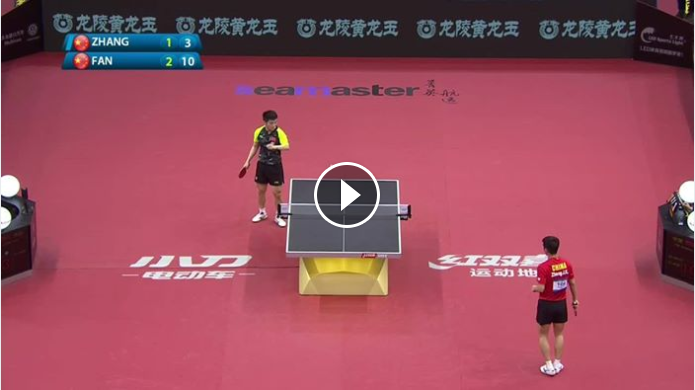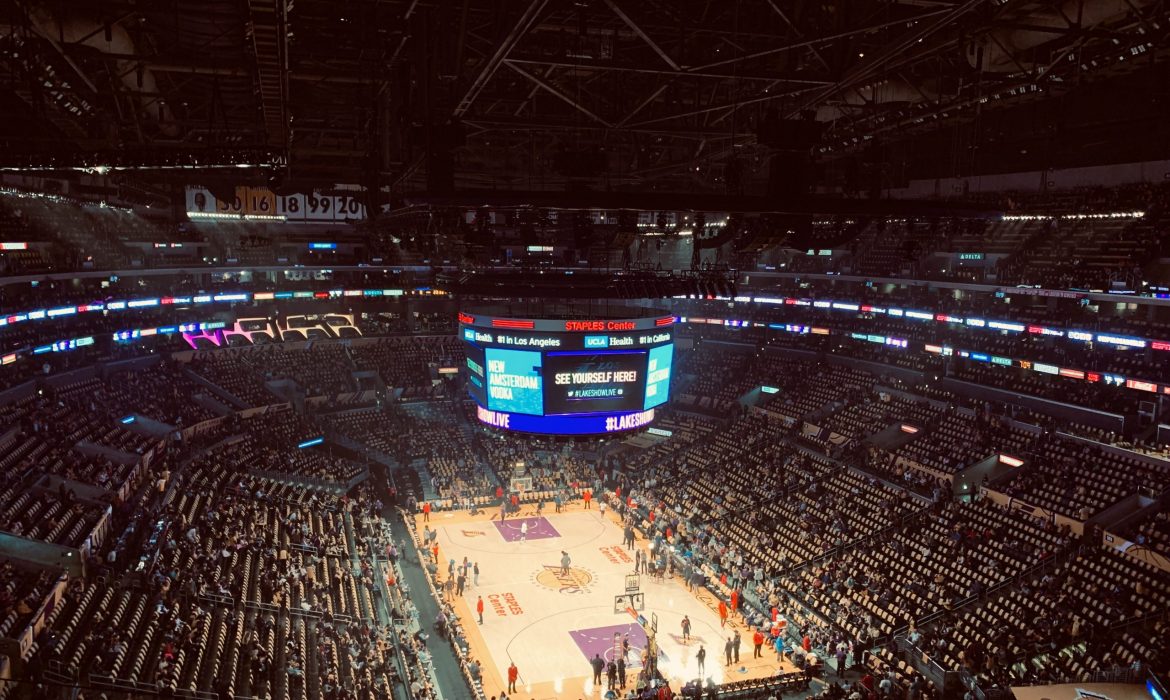A three-point plan for broadcasters sharing content during live events
Social media marketing that’s ‘in the moment’ has huge potential and value for broadcasters.
Through social channels, your viewers can be made to feel as if they’re in the moment. They can experience something as if they are there in person, rather than watching a recording.
You have two options: you can use live streaming, or create and share content in real-time.
1. Choose your channel wisely
First up, choosing the best channel is vitally important. Think about what you want to achieve and look for your audience. Also, consider how easy it will be to manage each channel for your event. Here’s a quick rundown of your main options:
Facebook Live
The king of live streams, Facebook Live has the potential to pull in huge audiences. Its users spend three times longer watching live video (than video that’s not live).
Facebook’s live streaming is easy to use and share. When BuzzFeed decided to explode a watermelon one rubber band at a time, little did they know it would be one of Facebook Live’s biggest hits. Over 800,000 people tuned in during the broadcast’s peak. It has since amassed more than 11 million views.
If you’re planning to share in real-time (as opposed to immediately live), Facebook is also a perfect place for short-form videos. Clips and highlights work well.
The International Table Tennis Federation use its live streams and our platform to create and drive short-form videos out to social media. In the process, they engage with and pull in fans.
Twitter is all about moments. The platform is fast becoming the place to watch live events and experience real-time action. It wants to be “the first place where people hear of what matters”, says its CEO Jack Dorsey.
From sports to news to entertainment programming, it has streamed more than 800 hours of live content in Q1 2017, reaching 45 million viewers. But it’s not just for big brands. Twitter live streaming is open to everyone.
But where Twitter slams it… real-time sharing…
John Wall, are you for real?! #SCtop10 pic.twitter.com/p8eP75r0Wo
— SportsCenter (@SportsCenter) May 8, 2017
YouTube
YouTube is a great place to live stream content. It is utilised by news channels, TV shows and even streams live from the International Space Station.
2. Prep, prep, prep
No matter what channel you choose, put in lots of prep before your live event. The first thing to do here is…
Have your graphics ready
For example, in the French Ice Hockey League the Rouen Dragons have created a bumper at the beginning of each clip. It shows both the Fanseat and sponsor’s logo. The graphic has been pre-prepared for each clip and is inserted using our Tellyo platform.
Be active during breaks
Create short highlight clips in real-time and share these during breaks, such as at half time. This will whet your fans’ appetite for more.
.@KingJames & @kevinlove combine for 36 points in the first half to lead the @cavs! #NBAPlayoffs pic.twitter.com/NtKov04sey
— NBA on TNT (@NBAonTNT) May 18, 2017
If not video, plan photos you can share during the build-up to an event or as things are happening.
Lookout for extras
If you’re multicasting, you will create a lot of footage that might never get used. Have someone in your social media or marketing team on the lookout for funny moments or behind-the-scenes footage. Turn these into social videos.
Here’s a great example of a funny clip, which is the kind of thing you might also choose to share:
Mascot took his shirt off for JR LMFAOO pic.twitter.com/4pIDQKrpRZ
— Scottie Pimppen (@BullsLegacy) May 11, 2017
If not video, plan photos you can share during the build-up to an event or as things are happening.
3. Learn from other industries
Always be on the lookout for inspirational examples of live streaming and real-time sharing.
The first here is a classic from Oreo, seizing on the black-out during 2013’s Super Bowl final:
Power out? No problem. pic.twitter.com/dnQ7pOgC
— Oreo Cookie (@Oreo) February 4, 2013
Dunkin Donuts hilariously joined the viral blue/black or white/gold dress debate with this tweet:
Doesn’t matter if it’s blue/black or white/gold, they still taste delicious. #thedress pic.twitter.com/Oq8srrAKnd
— Dunkin’ Donuts (@DunkinDonuts) February 27, 2015
And when Luis Suarez bit Giorgio Chiellini during 2014’s World Cup, Snickers were quick to respond:
Hey @luis16suarez. Next time you’re hungry just grab a Snickers. #worldcup #luissuarez #EatASNICKERS pic.twitter.com/3RAO537HjW
— SNICKERS® (@SNICKERS) June 24, 2014
Understanding the power of online sports videos
A huge amount of video is now being watched online, on mobiles and on social media.
Sensing a shift in content consumption trends, technology conglomerate Cisco used its vast resources to delve into the online video boom. Its findings? A firm prediction that video will account for over two-thirds of all consumer internet traffic in 2017.
For us digital marketers, a wealth of evidence points to the importance and benefits of online video content. Facebook now generates 8 billion video views every day; while the average amount of time consuming online videos per day increased by 20 per cent last year.
Following its own study, research giant Forrester placed huge value in online video. If a picture paints 1,000 words, then one minute of video is worth 1.8 million says its researchers.
[bctt tweet=” If a picture paints 1,000 words, then one minute of video is worth 1.8 million” username=”TellyoTV”]
Online videos and sports
If we take a closer look at the world of sports, the ways in which we consume video are changing too. Younger fans increasingly turn to social media for sports content.
In a Whistle Sports Study, 13 to 24-year-olds were asked where they go to consume sports-related video content. The response: YouTube and Facebook were the winners (64% listed YouTube and 53% Facebook).
Taking a step back, social media itself has undoubtedly changed the sports world. This is evident in the availability of live scores to thousands of facts literally at hand on your smartphone. Sports stars now seem more accessible, while reaction and fan interaction is instantaneous. Social media and particularly social video bring all of this together.
[bctt tweet=”Sports videos are a powerful and inherently shareable way to generate reactions & interactions” username=”TellyoTV”]
Social video reaction to the NBA All-Star Game
When distributed socially, sports videos are a powerful and inherently shareable way to generate reaction, interaction and fan banter. This was evident when Anthony Davis scored 52 points on his way to earning the Most Valuable Player award at the 2017 NBA All-Star Game in New Orleans.
Hometown Hero #AnthonyDavis sets a new #NBAAllStar game record with 44 points! pic.twitter.com/r92lEFwrY3
— NBA (@NBA) 20 lutego 2017
Real-time reaction lit up Twitter, much of which centred on official videos of offensive plays and dramatic moments. With tweeter’s personalised tweets and humorous GIFs added to the mix, alongside the NBA’s own longer-form highlight clips, the event generated engagement levels that any sports marketer would be ecstatic about.
What Kerr, Westbrook & Durant just did to Twitter. pic.twitter.com/R6eDYu0RDN
— Tim and Sid (@timandsid) 20 lutego 2017
Guys used to get a Kia for winning All-Star MVP but now they get Boogie as a teammate.
— Zach Harper (@talkhoops) 20 lutego 2017
What does this mean for sports marketers?
Social video is sports marketing gold dust. It has an innate ability to capture the moment – such a play of the game – while also being inherently shareable.
As with the NBA All-Star example, video is often the driving force behind social media debate and online interactions amongst fans. It is a vitally important element of sports digital marketing in today’s social media driven world. Captivate and engage your fans in the moment with social videos, and they will interact with and share them with others.
5 of our favourite sports video commercials
Here at Tellyo we understand the power of video. We believe it can help brands to form an emotional connection with consumers, something we see video achieve every day.
A hot-bed of creativity, we love sports video commercials. Always inventive, our favourites reach beyond the traditional business-to-consumer relationship. They truly appeal to potential consumers by reaching below the surface to what’s important to these people. What they believe in, what they stand up for, and what values they get behind.
Here we’ve chosen five of our favourite sports video commercials.
Sport needs creators by Adidas
Adidas’ video is a pumped one-minute motivational talk. It encourages you to be you, which is what will make the difference. It doesn’t need to say ‘buy Adidas, it’ll make you great at sport’ but cleverly puts each viewer’s destiny in their own hands. “Tap into your imagination and use your creativity to be the difference”, says the voiceover. “If you call yourself an athlete, create something. Sport needs you.”
Human by Reebok
Reebok’s Human campaign centres on the achievements of everyday people. It shows that anyone can grow as a human being through sport. It takes the idea of hands being the storyboard of a person’s life. Each callus representing effort, commitment, dedication, someone’s journey through life. “Because for every callus on our hands, and scar on our bodies,” says Reebok, “an even deeper mark is made within. We become more human.”
#ThisGirlCan
Sport England’s National Lottery funded #ThisGirlCan campaign inspires woman to take part in sport. Powered along by Missy Elliot’s Get Ur Freak On, it showcases a range of brilliant woman of all shapes and sizes. The women are not only taking part in sport, but smashing stereotypes and breaking barriers. “I kick balls,” says one of the overlays. “Deal with it.”
NikeWomen
Nike’s video promotes gender equality by showcasing Middle Eastern female sports stars. Published just before International Women’s Day, the video progressively presents the hijab in sport and promotes women’s participation in the Middle East. The video asks: “What will they say about you? Maybe they’ll say you showed them what was possible.”
Nike presents Da Da Ding
A longer-form music-style video, Da Da Ding was India’s first Nike advert. It aimed to address the image problem experienced by women’s sport in the country, by making it cool. Gizzle’s soundtrack sets a dramatic pace, while featured female stars reflect the diversity of India and of sport in the country. The spirit of Nike shines through to the soaring chant at the video’s end: “Da Da Ding, Da Da Ding. Let’s go!”
What do you think of our choices? Are there any you would add to the list?
A sport marketer’s simple guide to Facebook post promotion
Facebook can feel like a new frontier at times. Being active on your fan page can help build a bridge between your brand and potential customers. But what if your Facebook posts aren’t quite reaching the people you want to reach?
Here we provide some simple-to-use tips on how to use Facebook advertising options to promote your posts.
1. Power up with Power Editor
A hidden gem within Facebook is the Power Editor. While you can ‘boost posts’ directly from your fan page, this form of promotion has limitations.
The Power Editor gives you more advanced options to build target audiences and promote posts. As its name suggests, the Editor gives you more power.
For example, you can exclude people from a target group, helping to narrow down your audience. What’s more, when building a group, you can select people based on two (or more) options. Here I’d choose to show an ad to people interested in sports but who must also match having their relationship status set to ‘married’. As shown in the graphic below, my promoted post would reach 12million men between 22-45 in the US.
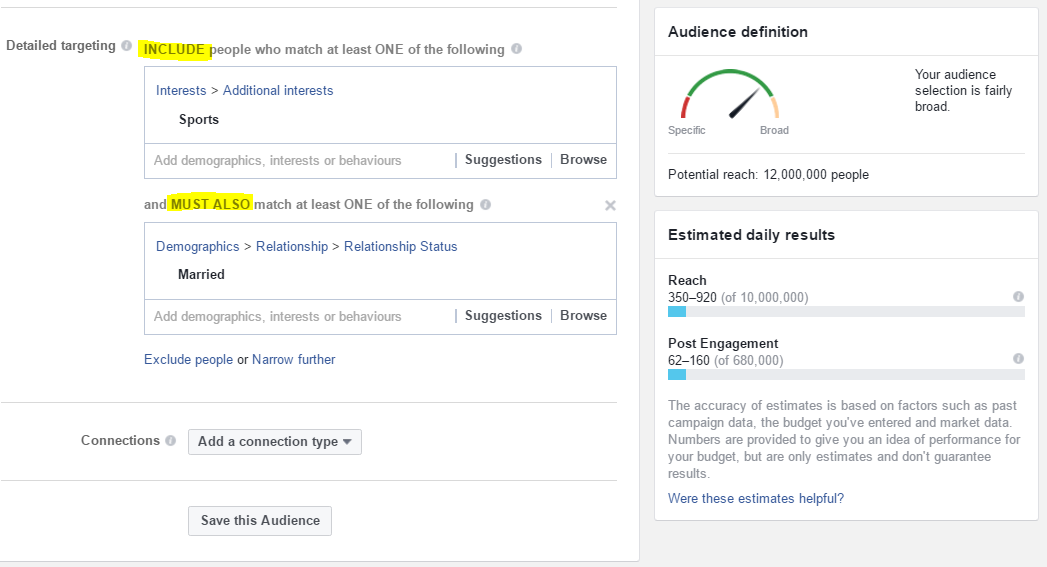
2. Define by using Ad Sets
In my opinion, creating a single worldwide audience is not a good idea. I find it more effective to put countries, cities or regions into separate Ad Sets, especially if you want people from different places to engage.
The reason for this is based on how Facebook works. It will seek the best price/clicks ratio and will show your post accordingly. So, if people in Argentina were to engage more with your post, the ad would be shown mostly to people in this country. You still might want people in France or Italy to see your ad, but because it did not perform well in these countries it will be omitted if the audience is ‘worldwide’.
I’d suggest duplicating your Ad Set and changing the location of each new one you create. You may find that some sets deliver worse results and/or become more expensive. However, you will be certain that people are seeing your posts in the countries, cities and regions you want to target.
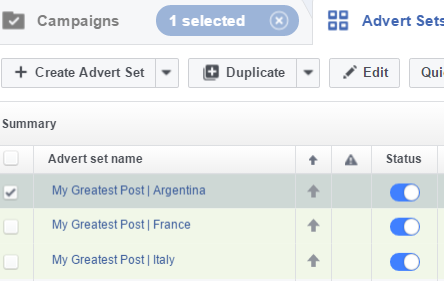
3. Exclude people and narrow down audiences
Facebook is full of fake profiles. You don’t want your promoted post to show in a fake profile’s feed. You want it to be promoted to real people: your current and future fans.
It’s important to be smart when excluding and narrowing people to avoid fake profiles. Education level setting will help you achieve that since a lot of those profiles will not have that set up. For sports, I’d maybe start with ‘high school leaver’, since the target audience is likely to be a younger demographic.
Excluding is trickier. It needs to be specific to each group, location, gender etc. When targeting ‘sports’ I would exclude those connected somehow with ‘laziness’ or ‘doing nothing’, whatever is hiding behind that. As you can see in the graphic below, with these two exclusions my initial group has dropped from 12 to 7.6 million.
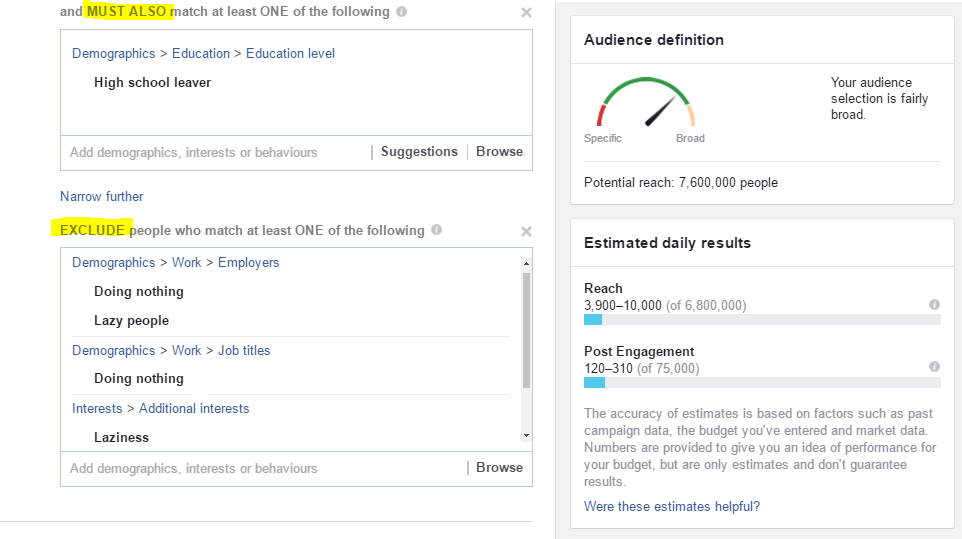
4. Be specific, but broaden if results aren’t coming
While my target group is still big (7million+), this is because ‘sports’ is very broad topic. A promoted post would reach anyone with a connection to any Facebook page about sport in general.
I would need to be more specific. If I was marketing a basketball club, I would change ‘sports’ to ‘basketball’. In doing so my group reduces to 3million.
I might also look at whether targeting the US is too generic. For starters, I may choose to target a few states only but including the state my team is from. In the example used throughout this post, if I pick California (go Lakers!) then my target group drops to 290,000. This feel like a more manageable number to start with, enabling me to target a specific audience and get more meaningful results.
The above are some simple tips to help you promote your Facebook posts more effectively. If you have any additional questions, please reach out to us on Twitter @TellyoTV. Or you can drop me an email at matt@tellyo.com
5 sports brands mastering real-time marketing
Technology provides both video creators and consumers the means to revel in video. For sports brands, video marketing is the go-to tactic to engage with fans. For fans, video feeds their passion and enables them to experience the action.
Here we’ve rounded up five sports brands mastering real-time marketing.
1. Australia National Cricket Team
Among the big batting brands, the Aussies lead the way with real-time marketing. During games, they package and share video highlights. The team puts its own spin on things by commenting on the action to spark conversations.
The highlights are the most viewed and commented clips on the team’s Facebook page.
2. Rouen Dragons – French Ice Hockey League
The Dragons prove that video marketing can build online audiences for more niche sports. Using Tellyo, they share match highlights straight after the whistle blows. Fans are then able to watch the action and goals as soon as possible.
The club reaches 200,000 people per month, with more than 40,000 viewing their videos per month. Impressive stats for a niche sport in France.
3. Cleveland Cavaliers – Current NBA champions
The Cavaliers switch how they treat video. Instead of on-field their real-time videos are strictly off-court. They will show the team entering the arena, or reveal footage of players backstage (something rarely seen on TV).
Behind-the-scene videos generate the most views and engagements. Even more so than the team’s slicker Top Plays highlight clips.
4. PGE Skra Bełchatow – Polish volleyball team
Skra Bełchatow confirm you don’t have to be in the big league to make live video streaming a success. They provide a very inside perspective of the team, streaming a game’s build up and preparation.
With around 13,000 views per pre-game video, fans are enjoying these insider insights.
5. NCAA Lacrosse – USA College League
For a niche sport not broadcast on TV, the NCAA seized the opportunity presented by video. By live streaming games, NCAA fans get to see the action. They can also re-live key moments from this very competitive league.
If the above film doesn’t help you to feel in the moment, we don’t know what will! Unreal!


